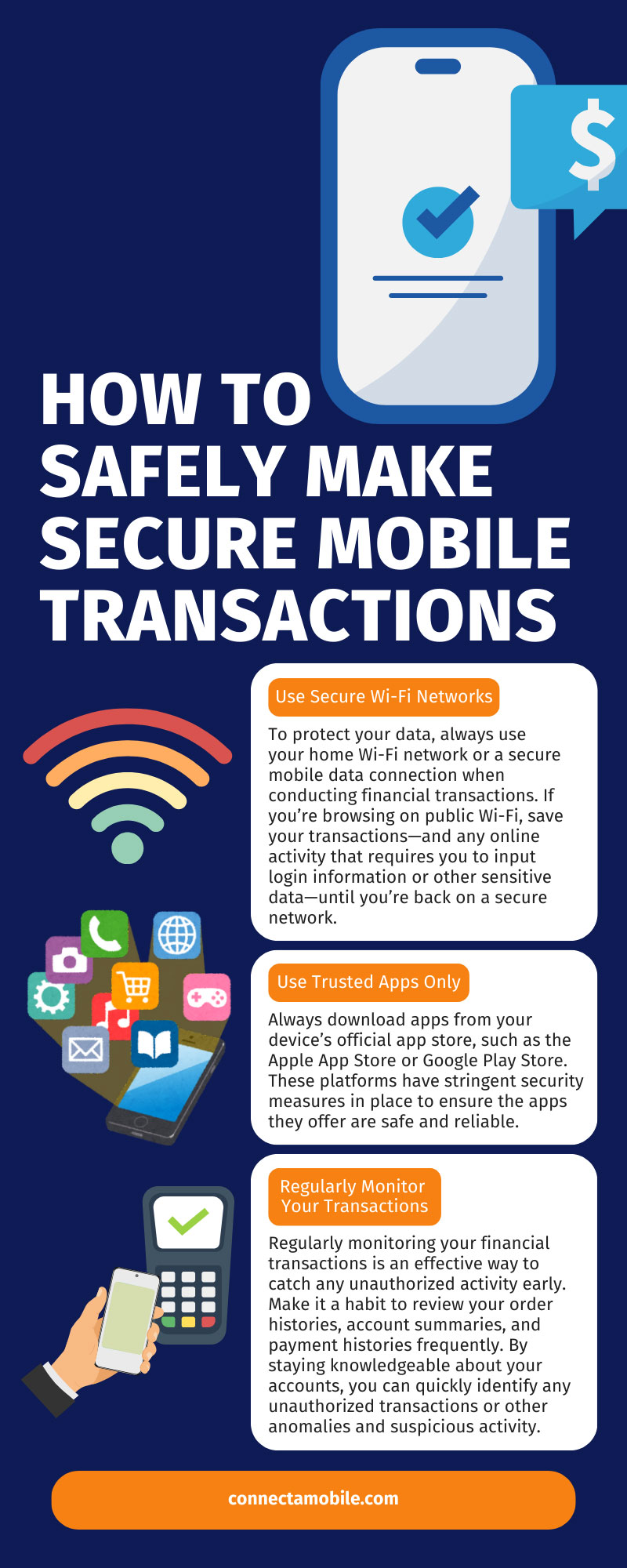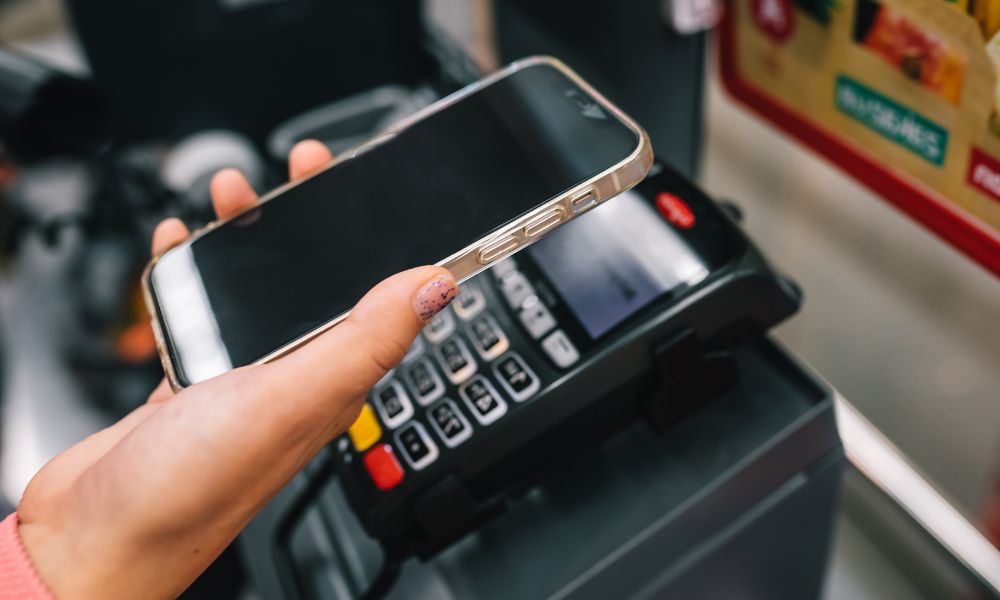With the rise of digital wallets, online banking apps, and e-commerce platforms, mobile transactions have become an integral part of our daily lives. Whether you’re buying groceries, paying bills, or transferring money to friends, the convenience of mobile transactions is undeniable.
However, this convenience comes with its own set of risks. From malware to phishing scams, cyber threats are becoming increasingly sophisticated. As people input, share, and store a notable amount of sensitive information through mobile devices and applications, those cyber threats are becoming more and more focused on phones, tablets, and other mobile technology.
Securing your mobile transactions is crucial to protecting your financial information and maintaining your peace of mind. Learn how to safely make secure mobile transactions and keep your device, information, and assets away from malicious parties.
Use Secure Wi-Fi Networks
When making mobile transactions, it’s crucial to use private and trusted Wi-Fi networks. Public Wi-Fi networks, such as those found in cafes, airports, and shopping centers, are often not secure. Hackers can easily exploit these networks to intercept any sensitive information you input, including your login credentials and financial details.
To protect your data, always use your home Wi-Fi network or a secure mobile data connection when conducting financial transactions. If you’re browsing on public Wi-Fi, save your transactions—and any online activity that requires you to input login information or other sensitive data—until you’re back on a secure network. You can also use a virtual private network (VPN) to protect your data wherever you go and provide an additional layer of security to your online transactions.
Use Trusted Apps Only
One of the most important steps in securing your mobile transactions is to be careful which mobile applications you install and use on your phone. Always download apps from your device’s official app store, such as the Apple App Store or Google Play Store. These platforms have stringent security measures in place to ensure the apps they offer are safe and reliable.
Before downloading an app, take a moment to check its reviews and ratings. High ratings and positive reviews can be a good indicator that the app is trustworthy and performs well.
Additionally, prioritize using apps over websites on your mobile browser for transactions. When you use a mobile browser, you send your sensitive data—including personal information or credit card details—over the web. On an app, however, your information remains on the app’s user interface, creating more secure transactions than on a standard website.
Pro Tip: Use Secure Websites
While using apps is preferable, not every company has an official mobile app. If you do need to access accounts or make transactions through a mobile browser, always take the time to verify the security of the website.
An easy way to do this is to look for the HTTPS tag at the beginning of the web address. This indicates that the URL is secure and the data you submit can move safely between your device and the website’s server without interference from malicious third parties.
Additionally, keep an eye out for the padlock symbol in the address bar, which also signifies a secure connection. These small checks can significantly enhance your online safety.
Keep Devices and Apps Updated
Regular updates for your mobile applications and device’s operating system are not just about getting the latest features—they’re crucial for security as well. Software updates often include security upgrades and patches that fix vulnerabilities in your device or apps. Ignoring these updates can leave your device exposed to potential threats. Make it a habit to check for updates regularly and install them as soon as they become available to keep your device and transactions secure.
Secure Your Device With Comprehensive Access Controls
Securing your mobile device with comprehensive access controls is another critical step in making safe transactions. Start by setting a strong password for your device and any accounts that contain private information, such as credit cards, banks, stores or restaurants, and so on. A strong password should be at least eight characters long and include a mix of letters, numbers, and special characters.
Enabling two-factor authentication (2FA) adds an extra layer of security by requiring a second form of verification, such as a text message code or fingerprint scan, in addition to your password. Many modern devices offer biometric authentication options, such as fingerprint or facial recognition, which provide convenient and secure access to your device.
Pro Tip: Use a Password Manager
Lax passwords mean lax security. Using a password manager can help you stay on top of your login information and maintain robust and unique passwords for every personal account you have. Take advantage of password managers to further enhance the security of crucial accounts for banking, credit cards, insurance, loans, store memberships, and more.
Regularly Monitor Your Transactions
Regularly monitoring your financial transactions is an effective way to catch any unauthorized activity early. Make it a habit to review your order histories, account summaries, and payment histories frequently. By staying knowledgeable about your accounts, you can quickly identify any unauthorized transactions or other anomalies and suspicious activity.
Most banking and financial apps offer real-time notifications for transactions, allowing you to stay up to date with your account activity. If you notice any unauthorized transactions, report them to your bank or credit card company immediately to prevent further damage.
Use Secure Mobile Devices From Connecta Mobile
If you prioritize security, investing in protected mobile devices can provide an added layer of safety and confidence to all your online activity. Connecta Mobile offers devices equipped with cutting-edge security features, such as blockchain technology, 256-bit on-device encryption, and remote device management.
These features ensure that your mobile transactions—and all your browsing and communications—remain secure, even if your device is lost or stolen. On-device encryption safeguards your data by converting it into unreadable code, while blockchain technology adds a layer of security by recording transactions in a decentralized manner. And remote device management allows you to lock or wipe your device remotely, preventing unauthorized access to your sensitive information.
Don’t let the threat of malware, stolen data, and other cyberattacks overshadow your online activity. Keep your financial information safe and make transactions with confidence and peace of mind when you invest in secure mobile solutions from Connecta Mobile. Learn more about our encrypted communication devices and find a phone that protects your privacy and security when you visit us today.

